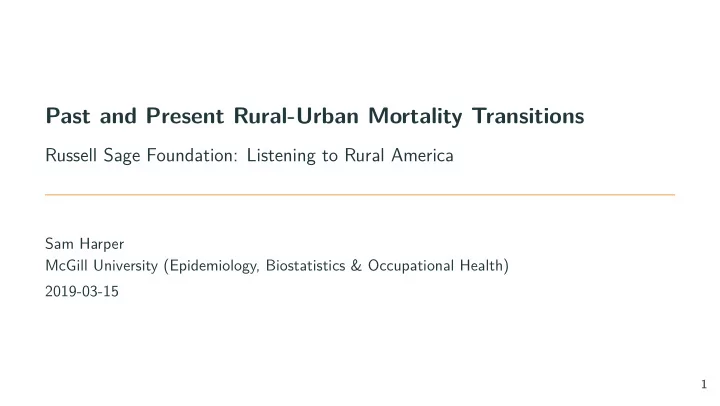

Past and Present Rural-Urban Mortality Transitions Russell Sage Foundation: Listening to Rural America Sam Harper McGill University (Epidemiology, Biostatistics & Occupational Health) 2019-03-15 1
The Urban Mortality Penalty • For most of human history, cities have been dangerous for health. • Location typically mattered more than income. • Clean water and adequate sanitation played a key role in reducing mortality in urban areas. Haines 1991, Johansson 1999, Cutler and Miller 2004. Cartoon by Pinwell (1866) 2
Mid-century equivalence in USA • Rural mortality rates on par with urbanized areas • Whole population experiencing epidemic of heart disease. Source: Vital Statistics of the United States, 1940 3
Post-war divergence • Divergence with decline in CVD and cancer mortality. • Increasing rural-urban divergence over time. Source: James 2014 4
Recent Mortality Trends (age-adjusted) 900 • Mortality slowdown Rate per 100,000 population NonCore (Nonmetro) 850 almost everywhere. Micropolitan (Nonmetro) • Rural areas still show 800 Small Metro excess mortality. 750 Medium Metro • Rural-urban mortality gap has widened. 700 Large Fringe Metro Large Central Metro 2000 2005 2010 2015 Source: Author’s tabulations by 2013 Rural-Urban continuum code from CDC WONDER 5
Increasing gap in life expectancy at birth since the 1970s Source: Author’s calculations. 6
Variation by Census Region Census Region 1: Northeast Census Region 2: Midwest 1000 900 • Rural disadvantage 800 Rate per 100,000 population everywhere at 700 X2013.Urbanization present. Large Central Metro 600 Large Fringe Metro Medium Metro Census Region 3: South Census Region 4: West • Notably larger gap Micropolitan (Nonmetro) 1000 NonCore (Nonmetro) in US South. Small Metro 900 • Recent trends also 800 bad in Midwest. 700 600 2000 2005 2010 2015 2000 2005 2010 2015 Source: Author’s tabulations from CDC WONDER 7
Trends in Unintentional Drug Poisoning Mortality (age-adjusted) Synthetic opioid phase • Population-wide Medium Metro Large Fringe Metro 20 increases. Heroin phase Rate per 100,000 population Micropolitan (Nonmetro) Large Central Metro Small Metro • Rural areas were Prescription painkiller phase NonCore (Nonmetro) more affected by prescription 10 painkillers. • Lowest rates in the most rural counties. 0 2000 2005 2010 2015 Source: Author’s tabulations from CDC WONDER, Kiang et al. 2019 8
Increasing contribution of chronic diseases to rural gap in life expectancy Source: Author’s calculations. 9
County-level age-adjusted cardiovascular mortality, 2014 • Excess deaths from CVD in East and West South Central regions. • Rural areas still show excess mortality, but regional heterogeneity. Source: Dwyer et al. 2016 10
Rural disadvantage for important chronic disease risk factors Smoking in men (2012) Low physical activity, women (2011) Lower → Higher prevalence Lower → Higher prevalence Source: Institute for Health Metrics & Evaluation (https://vizhub.healthdata.org/subnational/usa) 11
Potential life-long influence of early life rural residence? • Farm and rural residence in childhood increased probability of survival to old age among blacks. • Childhood rural residence associated with reduced mortality in NLS. • Residence in "Stroke Belt" in childhood associated with excess risk of stroke in adulthood. Preston et al. 1998, Hayward et al. 2004, Glymour et al. 2008 12
Difficult methodological challenges to isolate mechanisms • Need modern methods for mediation analysis. • Hard to account for unmeasured confounders ( U s). • Time-varying confounding by measured C s. Pearl 2000, De Stavola and Daniel 2016, VanderWeele 2017 13
Points for discussion • The rural-urban mortality gap is widening. • Largely due to non-communicable, chronic diseases. • Important heterogeneity by gender and region. • Potential for lifecourse impacts. Contact me at sam.harper@mcgill.ca or http://samharper.org 14
Recommend
More recommend